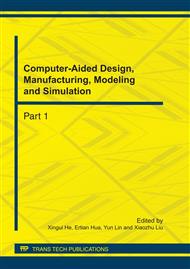[1]
Luo Xiping, Tian Jie. Image Enhancement and Minutia Matching Algorithm in Automatic Fingerprint Identification System. Journal of Software, 2002, 13(5): 946 – 956.
Google Scholar
[2]
B. G. Sherlock, D. M. Monro and K. Millard. Fingerprint enhancement by directional fourier filter. IEE Proc. Vis. Image Signal Processing, 1994, 141(2): 87 – 94.
DOI: 10.1049/ip-vis:19949924
Google Scholar
[3]
L. Hong, Y. Wan and A. K. Jain. Fingerprint image enhancement: Algorithm and performance evaluation. IEEE Transactions on PAMI, 1998, 20(8): 777 – 789.
DOI: 10.1109/34.709565
Google Scholar
[4]
Y. Yin, X. Zhan, T. Tan, et al. An Algorithm Based on Gabor Function for Fingerprint Enhancement and Its Application. Journal of Software. 2003, 14(3): 483 – 489.
Google Scholar
[5]
W. Wang, J. Li, F. Huang, et al. Fingerprint Enhancement based on Log-Gabor. Computer Science, 2007, 34(7): 241 – 243.
Google Scholar
[6]
L. Hong, A. K. Jain, S. Pankanti et al. Fingerprint enhancement. Proceedings of IEEE Workshop on Applications of Computer Vision, Sarasota, FI, (1996): 202 – 207.
Google Scholar
[7]
T. Kamei and M. Mizoguchi. Image filter designfor fingerprint enhancement. Proc. ISVC'95, Coral Gables, FL, (1995): 109 – 114.
Google Scholar
[8]
Y. Wu, L. Yang. An Improved Orientation Filter-based Algorithm for Fingerprint Enhancement. Jourmal of Huazhong University Science & Technology ( Nature Science Edition ), 2007, 35(2): 22 – 25.
Google Scholar
[9]
D. C. Douglas Hung. Enhancement feature purification of fingerprint images. Pattern Recognition, 1993, 26(11): 1661 – 1671.
DOI: 10.1016/0031-3203(93)90021-n
Google Scholar
[10]
L. O'Gorman and J. V. Neckerson. An approach to fingerprint filter design. Pattern Recognition, 1998, 22(1): 29 – 38.
Google Scholar
[11]
J. Cheng, J. Tian, Y. He. Fingerprint Enahcement Based on Nonlinear Diffusion Filter. Journal of ACTA Automatic Sinica , 2004, 20(6): 854 – 862.
Google Scholar
[12]
Z. Peng, X. Peng, G. Wu. Fingerprint Enhancement Algorithm Based on Non-stationary Signal Frequency Spectrum Analysis. Journal of Data Acquisition and Processing, 2008, 23(1): 35 – 39.
Google Scholar
[13]
X. Zhan, Y. Yin, X. Meng, et al. Research on Fingerprint Image Enhancement Algorithm Based on Two-Dimensional Sine Quadric Surface Filter. Journal of Shandong University ( Engneering Science Edition), 2009, 39(2): 8 – 14.
Google Scholar
[14]
X. Zhan, X. Ning, Y. Yin, et al. The Algorithm for Distilling Fingerprint Orientation in Multi-level Block Size. Journal of Nanjing University (Nature Science Edition), 2003, 39(4): 476~482.
Google Scholar
[15]
Y. Chen, Y. Yin, X. Zhang, et al. A Method Based on Statistical Window for Ridge Distance Estimation in Fingerprint Image. Journal of Image and Graphics, 2003, 8(3): 266~270.
Google Scholar


